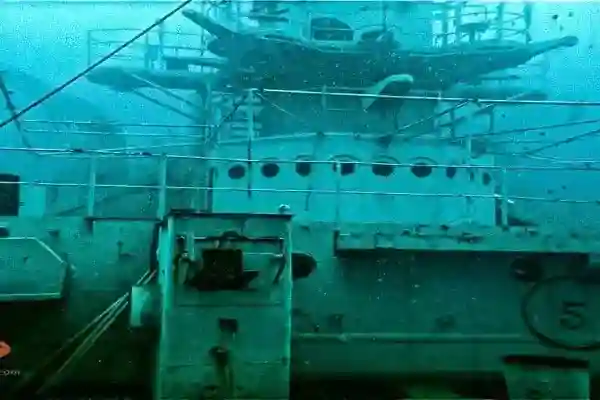Dive HTMS Chang – Thailand's Largest Shipwreck at Koh Chang
Picture this: You're descending through crystal-clear tropical waters off the coast of Koh Chang, Thailand, when suddenly a massive shadow emerges from the depths. As you get closer, the outline becomes clear – you're about to explore HTMS Chang, Thailand's largest and most spectacular shipwreck. At 100 meters long, this isn't just any wreck; it's a bucket-list dive that combines history, adventure, and some of the most incredible marine life encounters you'll ever experience.
The story of HTMS Chang reads like something from an adventure novel. Originally launched as the USS Lincoln County (LST-898), this landing ship tank saw action in World War II and the Korean War before being sold to the Royal Thai Navy in 1962. For decades, it served Thailand's navy, but its greatest adventure was yet to come. On November 22, 2012, the ship was intentionally sunk near Koh Chang to create an artificial reef – and what a reef it became!
Today, HTMS Chang is more than just a wreck dive; it's a thriving underwater metropolis. The structure sits perfectly upright on a sandy bottom at 30 meters, creating an underwater playground that's home to everything from tiny nudibranchs to massive barracuda schools. The wreck's decks, cargo holds, and passageways are now covered in colorful soft corals, sponges, and anemones, creating a vibrant contrast against the steel structure. It's like diving into a living, breathing underwater city where history meets marine biology in the most spectacular way.
What makes HTMS Chang truly special isn't just its size or history – it's the experience. Whether you're a wreck diving enthusiast, an advanced diver looking for your next challenge, or someone who simply wants to see what all the fuss is about, this dive delivers. The wreck is accessible enough for Advanced Open Water divers yet complex enough to keep even the most experienced wreck divers coming back for more. And let's be honest – there's something undeniably cool about swimming through a ship that once sailed the world's oceans, now transformed into a sanctuary for marine life.
So, are you ready to dive into history? HTMS Chang isn't just Thailand's largest shipwreck – it's an underwater adventure that combines the thrill of wreck diving with the beauty of Koh Chang's marine ecosystem. Book your dive with Chang Diving Center and discover why this wreck has become one of Southeast Asia's most sought-after dive sites. Trust us, your Instagram feed will thank you!
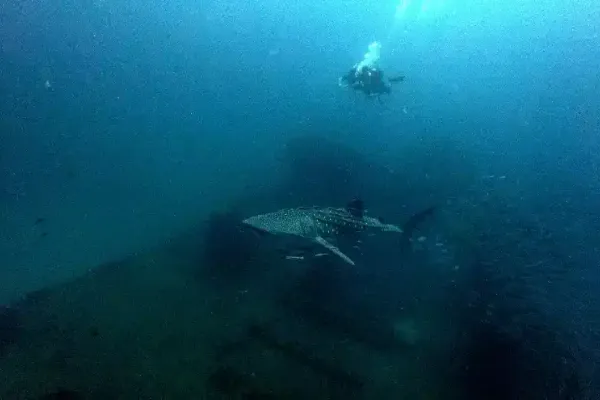
Whale shark at HTMS Chang wreck, captured on January 8, 2025.
Why Dive at HTMS Chang?
- Thailand's Largest Shipwreck: At 100 meters long, it's the biggest wreck in Thailand and a bucket-list dive for wreck enthusiasts.
- Deep Adventure: Explore cargo holds at depths of 27–29 meters and swim through passageways for an unforgettable experience.
- Marine Life Galore: Spot barracudas, groupers, batfish, lionfish, and many reef fish that have made the wreck their home.
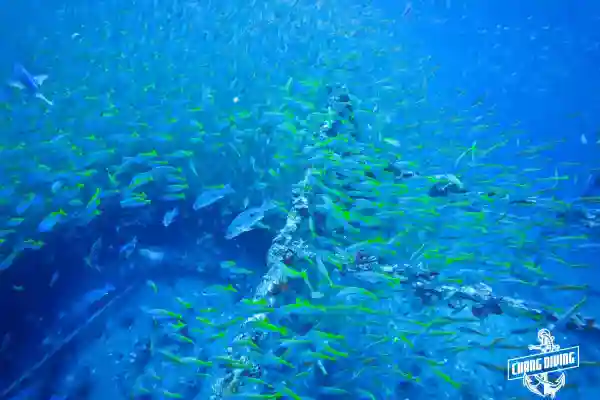
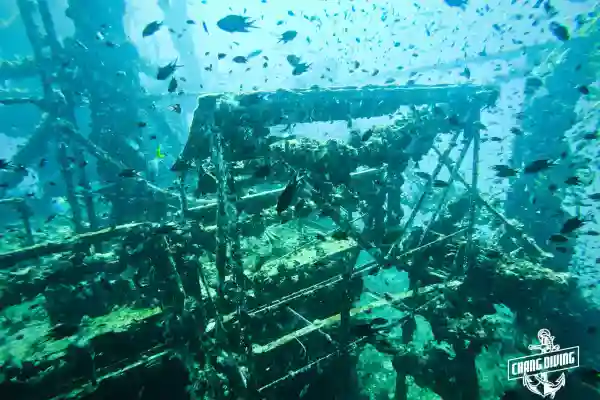

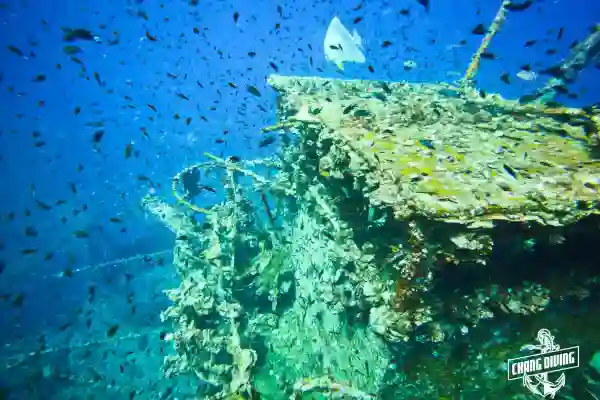
Dive Site Overview
| Max Depth | Deck Depth | Marine Life |
|---|---|---|
| 30 meters | 23 meters | Barracudas, groupers, batfish, lionfish, moray eels, reef fish |
Are you ready to explore Thailand's most iconic shipwreck? Book a fun dive or wreck diving course with Chang Diving Center today!

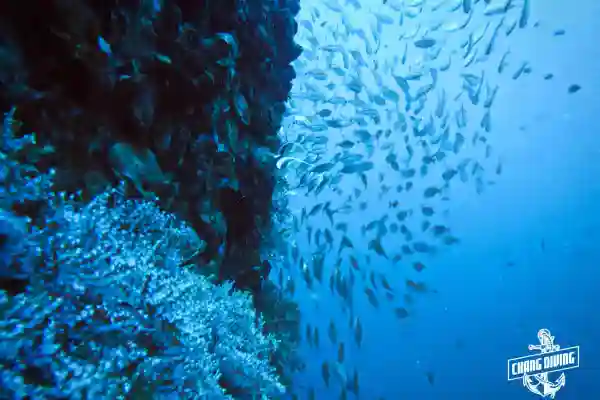
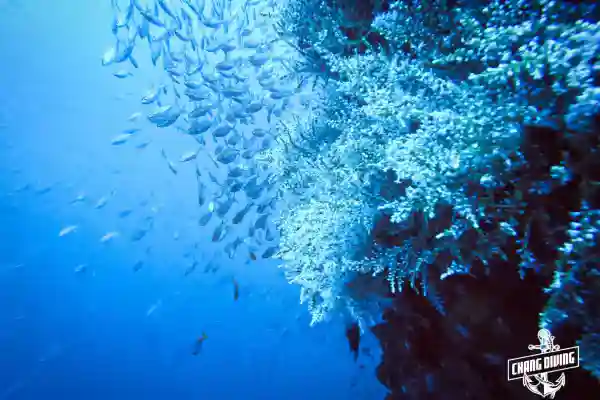
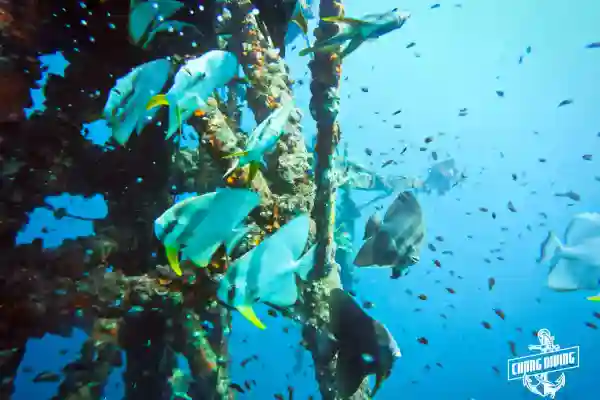
Diver Level for this dive site.
Min. certification level: Advanced Open Water Diver, Deep Diver, Wreck Diver (or equalled) Try Diving possibility: No Snorkelling possibility: NoDive Briefing Example for Dive Professionals – HTMS Chang Wreck
This is a comprehensive dive briefing template/example for dive professionals. Use this as a reference guide to structure your own briefings. Customize the placeholders (marked with brackets) with your specific information, guide names, and current conditions. This ensures a safe, organized, and professional dive briefing experience.
1. Dive Site Name & Introduction
Hello everyone and welcome to HTMS Chang! HTMS Chang is Thailand's largest and most iconic shipwreck dive site. At 100 meters long, this former US Navy landing ship (originally USS Lincoln County LST-898) was intentionally sunk in 2012 to create an artificial reef. It's now one of the most spectacular wreck dives in Southeast Asia.
My name is [Your Name] and I will be your dive guide today. I've been diving this wreck for [X] years and I'm excited to share this incredible site with you!
2. Site Description & Dive Route
We have excellent diving conditions today at HTMS Chang. The visibility is typically 15-25 meters, and we have calm surface conditions with minimal current.
- Maximum Depth: 30 meters (bottom of the wreck)
- Average Depth: 23-27 meters (main deck level)
- Dive Route: We'll descend along the mooring line to the bow at 23 meters, then swim along the port side, explore the cargo holds, and make our way to the stern. The wreck is completely intact and offers multiple penetration points for certified wreck divers.
- Weather Conditions: [Current conditions - e.g., "Low tide, wave height 0.5 meters, light surface current"]
The wreck sits upright on a sandy bottom, making navigation easy. The structure is covered in colorful soft corals, sponges, and anemones, creating a vibrant underwater city teeming with marine life.
What You Can See at HTMS Chang
HTMS Chang is a thriving artificial reef that attracts a diverse range of marine life. During your dive, you can expect to encounter:
- Large Pelagic Fish: Schools of barracudas often patrol the wreck, along with giant groupers that have made the structure their home
- Reef Fish: Colorful batfish, angelfish, parrotfish, and butterflyfish are abundant around the coral-covered structure
- Wreck Specialists: Lionfish, moray eels, and scorpionfish are commonly found hiding in the wreck's nooks and crannies
- Occasional Visitors: Green sea turtles, eagle rays, and even whale sharks have been spotted around the wreck (especially during certain seasons)
- Macro Life: Keep an eye out for nudibranchs, seahorses, and other small creatures on the coral-covered surfaces
For a complete guide to the marine life you might encounter while diving in Koh Chang, check out our Marine Life Guide. This comprehensive resource covers species identification, behavior, and the best spots to find different marine creatures.
3. Your Guide's Role & Positioning
I will be leading this dive and wearing [Color] and [Color] fins with a [Description of equipment/identifying feature]. You can easily identify me by [specific visual identifier - e.g., "my bright yellow BCD with the Chang Diving logo"].
[If applicable] Our Divemaster [Name] will be positioned at the back of the group, keeping an eye on everyone. [Name] will be wearing [Color] fins and will use [signal device - e.g., "this tank banger"] to get your attention if needed.
Important: Stay close to the group and maintain visual contact with your buddy and the guide at all times. If you need to communicate, use standard hand signals or get my attention by tapping your tank.
4. Entry & Exit Techniques
Boat Entry (Giant Stride)
We'll be entering from the side of the dive boat using a giant stride entry. Here's what to remember:
- Pre-dive Safety Check: Complete your BIG WHALES REALLY ARE FUN check before entering
- BCD Inflation: Fully inflate your BCD before entry
- Regulator: Keep your regulator in your mouth
- Mask: Ensure your mask is properly fitted
- Entry: Step forward with one leg, then the other, keeping your legs together
- After Entry: Clear the area immediately, signal OK, and swim to the mooring line
Boat Exit (Ladder)
After completing your safety stop and surfacing:
- Swim back to the ladder on the side of the boat
- Stand on the ladder and remove your fins (hand them to the crew)
- Climb up the ladder with your regulator still in your mouth
- CRITICAL: Never position yourself directly under another diver climbing the ladder
- Once on deck, move away from the entry/exit area
Dinghy Entry (Backroll)
If we're using a dinghy, we'll enter with a backroll entry:
- Sit on the edge of the dinghy with your back to the water
- Complete your pre-dive safety check
- Hold your mask and regulator in place
- On the count of three, lean back and roll into the water
- Clear the area and signal OK
5. Dive Procedures & Turn-Around Points
To ensure we have plenty of air for a safe return and safety stop:
- Turn-Around Point: We will turn the dive around when you reach 130 bars (or 1900 PSI). This gives us more than enough air reserve to safely return to the entry point and complete our safety stop.
- Air Monitoring: Check your air gauge frequently throughout the dive. Don't wait until you're low on air to signal - communicate early!
- Safety Stop: At 5 meters depth, we'll conduct a rolling safety stop for 3 minutes. This means we'll slowly swim in a circle while maintaining 5 meters depth, rather than holding onto a line.
- No-Decompression Limits: For this depth (23-30 meters), your no-decompression limit is approximately 20 minutes. We'll keep the dive well within these limits.
Remember: The most important rule in diving is to never hold your breath. Breathe normally and continuously throughout the dive.
6. Emergency Procedures
While we don't expect any problems, it's important that everyone knows what to do in case of an emergency:
Buddy Separation
- If you get separated from your buddy, search for 1 minute while staying at the same depth
- If you cannot find your buddy, make a controlled safety ascent to the surface
- Wait on the surface - we will reunite there
- DO NOT continue the dive alone
Out of Air / Low on Air
- Low on Air: Signal immediately - we'll end the dive and ascend together
- Out of Air: Signal "out of air" and use your buddy's alternate air source or make a controlled emergency swimming ascent (CESA)
- Always signal problems early - don't wait until it's an emergency!
Emergency Contacts & Equipment
- Police: 191
- Tourist Police: 1155
- Emergency Medical Services: 1669
- DAN International: +1-919-684-9111 (24/7 emergency hotline for diving emergencies)
- Recompression Chamber: Koh Chang Hospital, Phone: 039 521-657 or 039 586-131
- Suspicion of DCS: Refer to our DCS Field Evaluation Slate (PDF) for assessment procedures
- Emergency Oxygen: Located in the transport box on the right of the captain's seat in the captain's cabin
- First Aid Kit: Located in the transport box on the right of the captain's seat in the captain's cabin
- Emergency Action Plan: For detailed emergency procedures, please refer to our Emergency Plan Guide
7. Hand Signal Review
Hand signals can vary between countries and certification agencies, so let's make sure we're all on the same page. Here are the essential signals we'll use today:
- OK: [Description/visual] - Used to ask "Are you OK?" and respond "I'm OK"
- Problem: [Description/visual] - Wave hand side to side to indicate a problem
- Up: [Description/visual] - Thumb up means "I want to go up"
- Down: [Description/visual] - Thumb down means "I want to go down"
- Air Pressure: [Description/visual] - Show numbers with fingers (e.g., "I have 120 bars")
- Low on Air: [Description/visual] - Hand across throat
- Out of Air: [Description/visual] - Hand across throat, then point to regulator
- Safety Stop: [Description/visual] - Hand horizontal, palm down, at 5 meters
- Stop/Hold: [Description/visual] - Hand up, palm forward
- Look/Point: [Description/visual] - Point to something interesting
Practice Question: Can you show me how you would communicate that you have 120 bars of air pressure remaining?
📋 Download Complete Hand Signals Guide (PDF)
8. Roster & Buddy Check (Pairing)
Let's make sure everyone is present and properly paired up:
- Roster Check: [Go through names] - Is everyone here?
- Buddy Pairs:
- [Name] and [Name] - you'll be buddies
- [Name] and [Name] - you'll be buddies
- [Name] - you'll be my buddy today (for less experienced divers)
- Buddy Check: Before entering the water, do a final check with your buddy - make sure all equipment is secure and working properly
Note: Buddy pairs are typically matched by experience level and certification. If you'd like to dive with a specific person, please let me know now.
9. Environmental Awareness & Marine Hazards
HTMS Chang is a protected artificial reef, and we need to respect the marine environment:
- General Rule: Look but don't touch. Avoid contact with all marine life, including corals, sponges, and fish
- Marine Life to Be Aware Of:
- Lionfish: Beautiful but venomous - keep a safe distance (at least 2 meters)
- Moray Eels: Usually shy, but can be territorial - don't reach into holes or crevices
- Fire Coral: Can cause skin irritation - avoid contact
- Sea Urchins: Sharp spines - watch your hands and knees
- Barracudas: Large but generally harmless - maintain respectful distance
- Buoyancy Control: Maintain good buoyancy to avoid damaging the reef or stirring up sediment
- Photography: If taking photos, be careful not to touch anything. Use a camera tray or handle
- Conservation: Take only photos, leave only bubbles. Never remove anything from the wreck or reef
Remember: We're guests in their home. Let's be respectful visitors and leave the site exactly as we found it.
10. Pre-Dive Safety Check
Before every dive, we use the acronym "BIG WHALES REALLY ARE FUN" to ensure nothing is forgotten. For a detailed guide on why safety checks are important and how to perform them correctly, check out our Safety Check Guide:
- B - BCD: Check that your BCD inflates and deflates properly. Test the power inflator and dump valves.
- I - Inflation: Ensure your BCD is properly fitted and all straps are secure.
- G - Gauges: Check your SPG (Submersible Pressure Gauge), depth gauge, and computer. Ensure they're working and readable.
- W - Weights: Verify your weight belt or integrated weights are secure and properly positioned.
- H - Hose: Check all hoses for kinks or damage. Ensure your regulator hoses are properly routed.
- A - Air: Turn on your air, check your tank pressure, and take 2-3 breaths from your regulator.
- L - Releases: Test all quick releases on your BCD, weight system, and any other equipment.
- E - Everything: Double-check that everything is in place and working.
- S - Snaps: Ensure all snaps and buckles are secure.
- R - Releases: (Second check) Verify all releases are functioning.
- E - Everything: Final check - is everything ready?
- A - Air: Final air check - regulator working, tank pressure good.
- L - Look: Look around - is your buddy ready? Is the entry area clear?
- L - Listen: Listen for final instructions from your guide.
- Y - You: Are YOU ready? Take a deep breath, relax, and enjoy the dive!
- A - Again: One more quick check - everything secure?
- R - Ready: Are you ready to dive?
- E - Everything: Final everything check.
- F - Fun: Remember - diving is FUN! Relax and enjoy!
- U - Underwater: Ready to go underwater?
- N - Now: Let's dive NOW!
Pro Tip: Complete this check with your buddy. It's a great way to catch any issues before entering the water and helps build confidence.
📋 Quick Briefing Checklist
- ✅ Site name and conditions understood
- ✅ Dive route and depths clear
- ✅ Guide identification confirmed
- ✅ Entry/exit procedures reviewed
- ✅ Turn-around points and air reserves understood
- ✅ Emergency procedures clear
- ✅ Hand signals reviewed
- ✅ Buddy paired and checked
- ✅ Environmental awareness discussed
- ✅ Pre-dive safety check completed
Questions? If you have any questions or concerns, please ask now - I'm here to help! Remember, there are no stupid questions when it comes to dive safety. Let's have a safe and amazing dive! 🌊🤿
📝 After Your Dive: Log Your Experience
Don't forget to log your dive! Your dive logbook is an important record of your diving experience and is required for many advanced courses. Whether you use a digital app or a traditional logbook, make sure to record:
- Date and location
- Dive site name (HTMS Chang Wreck)
- Maximum depth and dive duration
- Air consumption (start and end pressure)
- Your buddy and guide
- Highlights (marine life spotted, conditions, etc.)
For more information on why dive logbooks are important and what to include, check out our Dive Logbook Guide. You can find the dive site stamp and get your logbook signed by your guide at the coffee station on the boat.
What other divers discovered
Real reviews and experiences from our guests – see what others found on their diving adventures with us!
More Wreck Dives
Explore more wreck diving adventures around Koh Chang. These historic wrecks offer fascinating underwater exploration and abundant marine life.

🚢 T11 Wreck
Explore the T11 shipwreck with its intact structure and abundant marine life. Perfect for wreck diving enthusiasts! (Max depth: 20m)

⚓ Koho Maru 5
Dive the historic Japanese cargo ship from WWII. An atmospheric wreck with fascinating history and marine encrustation. (Max depth: 43m)

🛳️ Phutthayotfa Wreck
Discover this Thai Navy vessel wreck with impressive structure and thriving coral growth. Great for underwater photographers. (Max depth: 40m)
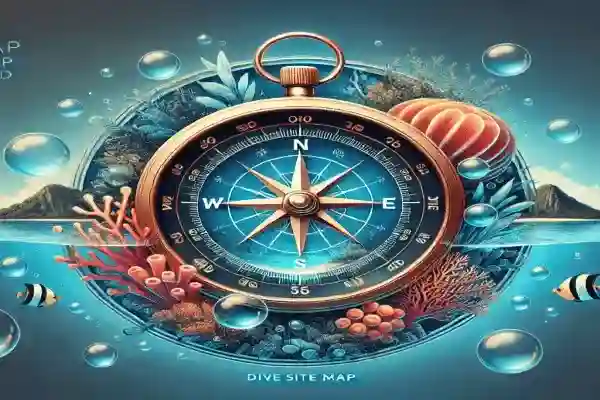
🗺️ View All Sites
Explore all 13 dive sites around Koh Chang. From shallow reefs to deep wrecks - find your perfect dive adventure.

